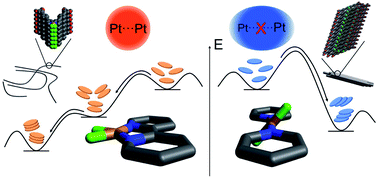Tuning energy landscapes and metal–metal interactions in supramolecular polymers regulated by coordination geometry†
Abstract
Herein, we exploit coordination geometry as a new tool to regulate the non-covalent interactions, photophysical properties and energy landscape of supramolecular polymers. To this end, we have designed two self-assembled Pt(II) complexes 1 and 2 that feature an identical aromatic surface, but differ in the coordination and molecular geometry (linear vs. V-shaped) as a result of judicious ligand choice (monodentate pyridine vs. bidentate bipyridine). Even though both complexes form cooperative supramolecular polymers in methylcyclohexane, their supramolecular and photophysical behaviour differ significantly: while the high preorganization of the bipyridine-based complex 1 enables an H-type 1D stacking with short Pt⋯Pt contacts via a two-step consecutive process, the existence of increased steric effects for the pyridyl-based derivative 2 hinders the formation of metal–metal contacts and induces a single aggregation process into large bundles of fibers. Ultimately, this fine control of Pt⋯Pt distances leads to tuneable luminescence—red for 1vs. blue for 2, which highlights the relevance of coordination geometry for the development of functional supramolecular materials.



 Please wait while we load your content...
Please wait while we load your content...